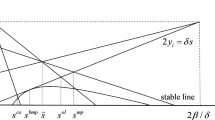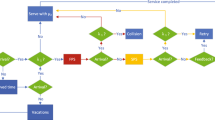Abstract
We present an introductory review of recent work on the control of open queueing networks. We assume that customers of different types arrive at a network and pass through the system via one of several possible routes; the set of routes available to a customer depends on its type. A route through the network is an ordered set of service stations: a customer queues for service at each station on its route and then leaves the system. The two methods of control we consider are the routing of customers through the network, and the sequencing of service at the stations, and our aim is to minimize the number of customers in the system. We concentrate especially on the insights which can be obtained from heavy traffic analysis, and in particular from Harrison's Brownian network models. Our main conclusion is that in many respects dynamic routingsimplifies the behaviour of networks, and that under good control policies it may well be possible to model the aggregate behaviour of a network quite straightforwardly.
Similar content being viewed by others
References
I.J.B.F. Adan, J. Wessels and W.H.M. Zijm, Analysis of the symmetric shortest queue problem, Stochastic Models 6 (1990) 691–713.
D.P. Bertsekas and R.G. Gallager,Data Networks (Prentice-Hall, Englewood Cliffs, 1987).
J.G. Dai and J.M. Harrison, Reflected Brownian motion in an orthant: numerical methods for steady-state analysis, Ann. Appl. Prob. 2 (1992) 65–86.
J.G. Dai and Y. Wang, Nonexistence of Brownian models for certain multiclass queueing networks, Queueing Systems 13 (1993), this issue.
A. Ephremides, P. Varaiya and J. Walrand, A simple dynamic routing problem, IEEE Trans. Autom. Control AC-25 (1980) 690–693.
L. Flatto and H.P. McKean, Two queues in parallel, Commun. Pure Appl. Math. 30 (1977) 255–263.
G.J. Foschini, On heavy traffic diffusion analysis and dynamic routing in packet switched networks, in:Computer Performance, eds. K.M. Chandy and M. Reiser (North-Holland, Amsterdam, 1977) pp. 499–513.
G.J. Foschini, Equilibria for diffusion models of pairs of communicating computerssymmetric case, IEEE Trans. Inf. Theory IT-28 (1982) 273–284.
G.J. Foschini and J. Salz, A basic dynamic routing problem and diffusion, IEEE Trans. Commun. COM-26 (1978) 320–327.
R.G. Gallager, A minimum delay routing algorithm using distributed computation, IEEE Trans. Commun. COM-25 (1977) 73–85.
E. Gelenbe and G. Pujolle,Introduction to Queueing Networks (Wiley, Chichester, 1987).
M. Gondran and M. Minoux,Graphs and Algorithms (Wiley-Interscience, New York, 1984).
F.A. Haight, Two queues in parallel, Biometrika 45 (1958) 401–410.
S. Halfin, The shortest queue problem, J. Appl. Prob. 22 (1985) 865–878.
J.M. Harrison,Brownian Motion and Stochastic Flow Systems (Wiley, New York, 1985).
J.M. Harrison, Brownian models of queueing networks with heterogeneous customer populations, in:Stochastic Differential Systems, Stochastic Control Theory and Applications, IMA Vol. 10, eds. W. Fleming and P.-L. Lions (Springer, New York, 1988) pp. 147–186.
J.M. Harrison and V. Nguyen, The QNET method for two-moment analysis of open queueing networks, Queueing Systems 6 (1990) 1–32.
J.M. Harrison and V. Nguyen, Brownian models of multiclass queueing networks: current states and open problems, Queueing Systems, 13 (1993), this issue.
J.M. Harrison and M.I. Reiman, On the distribution of multidimensional reflected Brownian motion, SIAM J. Appl. Math. 41 (1981) 345–361.
J.M. Harrison and M.I. Reiman, Reflected Brownian motion on an orthant, Ann. Prob. 9 (1981) 302–308.
J.M. Harrison and L.M. Wein, Scheduling networks of queues: heavy traffic analysis of a simple open network, Queueing Systems 5 (1989) 265–280.
J.M. Harrison and L.M. Wein, Scheduling networks of queues: heavy traffic analysis of two-station closed network, Oper. Res. 38 (1990) 1052–1064.
J.M. Harrison and R.J. Williams, Brownian models of open queueing networks with homogeneous customer populations, Stochastics 22 (1987) 77–115.
D.J. Houck, Comparison of policies for routing customers to parallel queueing systems, Oper. Res. 35 (1987) 306–310.
F.P. Kelly, The optimization of queueing and loss networks, in:Queueing Theory and its Applications, eds. O.J. Boxma and R. Syski (North-Holland, Amsterdam, 1988) pp. 375–392.
F.P. Kelly, On a class of approximations for closed queueing networks, Queueing Systems 4 (1989) 69–76.
J.F.C. Kingman, Two similar queues in parallel, Ann. Math. Statist. 32 (1961) 1314–1323.
L. Kleinrock,Queueing Systems,Vol. 2: Computer Applications (Wiley, New York, 1976).
H.J. Kushner,Probability Methods for Approximations in Stochastic Control and for Elliptic Equations (Academic Press, New York, 1977).
H.J. Kushner and L.F. Martins, Numerical methods for stochastic singular control problems, SIAM J. Control Optim. 29 (1991) 1443–1475.
H.J. Kushner and K.M. Ramachandran, Optimal and approximately optimal control policies for queues in heavy traffic, SIAM J. Control Optim. 27 (1989) 1293–1318.
C.N. Laws, Dynamic routing in queueing networks, PhD thesis, Statistical Laboratory, University of Cambridge (1990).
C.N. Laws, Resource pooling in queueing networks with dynamic routing, Adv. Appl. Prob. 24 (1992) 699–726.
C.N. Laws and G.M. Louth, Dynamic scheduling of a four-station queueing network, Prob. Eng. Inf. Sci. 4 (1990) 131–156.
L.F. Martins and H.J. Kushner, Routing and singular control for queueing networks in heavy traffic, SIAM J. Control Optim. 28 (1990) 1209–1233.
W.P. Peterson, A heavy traffic limit theorem for networks of queues with multiple customer types, Math. Oper. Res. 16 (1991) 90–118.
M.I. Reiman, The heavy traffic diffusion approximation for sojourn times in Jackson networks, in:Applied Probability-Computer Science: The Interface, Vol. 2. eds. R.L. Disney and T.J. Ott (Birkhäuser, Boston, 1982) pp. 409–422.
M.I. Reiman, Some diffusion approximations with state space collapse, in:Proc. Int. Seminar on Modelling and Performance Evaluation Methodology, Lecture Notes in Control and Informational Sciences 60, eds. F. Baccelli and G. Fayolle (Springer, Berlin, 1983) pp. 209–240.
M.I. Reiman, Open queueing networks in heavy traffic, Math. Oper. Res. 9 (1984) 441–458.
M.I. Reiman, A multiclass feedback queue in heavy traffic, Adv. Appl. Prob. 20 (1988) 179–207.
M. Schwartz,Telecommunication Networks (Addison-Wesley, Reading, MA, 1987).
S.R.S. Varadhan and R.J. Williams, Brownian motion in a wedge with oblique reflection, Commun. Pure Appl. Math. 38 (1985) 405–443.
R.R. Weber, On the optimal assignment of customers to parallel servers, J. Appl. Prob. 15 (1978) 406–413.
L.M. Wein, Optimal control of a two-station Brownian network, Math. Oper. Res. 15 (1990) 215–242.
L.M. Wein, Scheduling networks of queues: heavy traffic analysis of a two-station network with controllable inputs, Oper. Res. 38 (1990) 1065–1078.
L.M. Wein, Brownian networks with discretionary routing, Oper. Res. 39 (1991) 322–340.
L.M. Wein, Scheduling networks of queues: heavy traffic analysis of a multistation network with controllable inputs, Sloan School of Management, MIT, Boston, MA.
W. Whitt, Open and closed models for networks of queues, AT&T Bell Lab. Techn. J. 63 (1984) 1911–1979.
W. Whitt, Deciding which queue to join: some counterexamples, Oper. Res. 34 (1986) 55–62.
R.J. Williams, Recurrence classification and invariant measure for reflected Brownian motion in a wedge, Ann. Prob. 13 (1985) 758–778.
R.J. Williams, Reflected Brownian motion in a wedge: semimartingale property, Z. Wahrscheinlichkeitstheorie verw. Gebiete 69 (1985) 161–176.
W. Winston, Optimality of the shortest line discipline, J. Appl. Prob. 14 (1977) 181–189.
P. Yang, Pathwise solutions for a class of linear stochastic systems, PhD thesis, Dept. of Operations Research, Stanford University (1988).
Author information
Authors and Affiliations
Additional information
Supported by SERC grant GR/F 94194.
Rights and permissions
About this article
Cite this article
Kelly, F.P., Laws, C.N. Dynamic routing in open queueing networks: Brownian models, cut constraints and resource pooling. Queueing Syst 13, 47–86 (1993). https://doi.org/10.1007/BF01158929
Received:
Revised:
Issue Date:
DOI: https://doi.org/10.1007/BF01158929




